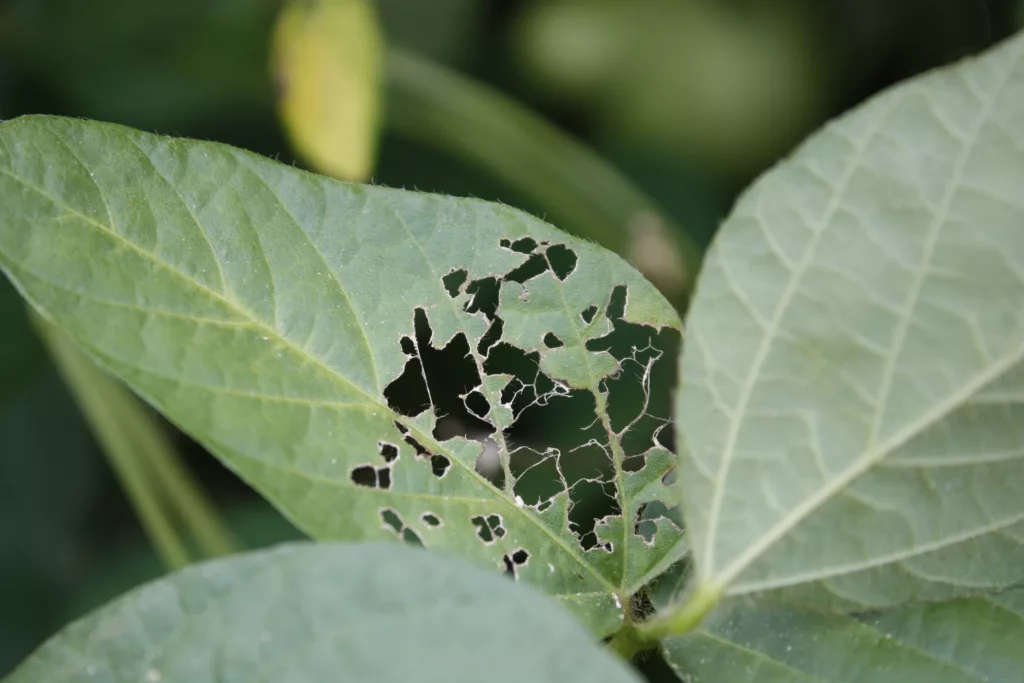The best way to combat pests in your vegetable garden is by being able to identify them. We’ve compiled the top 11 common pests that you will find in the garden, along with a photo of the insect and their damage, so you can take the first step in protecting your garden vegetables.
One thing you may notice in this article is that we do not recommend any insecticides or sprays beyond dish soap. We believe that pests can be managed organically, without the use of any chemicals (whether it is labeled as safe, or not) in order to protect all living beings in the garden. Remember, these insects feed those higher on the food chain. And because many chemicals are indiscriminate, they will kill any insect that is exposed to them, including bees and butterflies! We as gardeners need to work with nature, rather than against it.
Cucumber Beetle
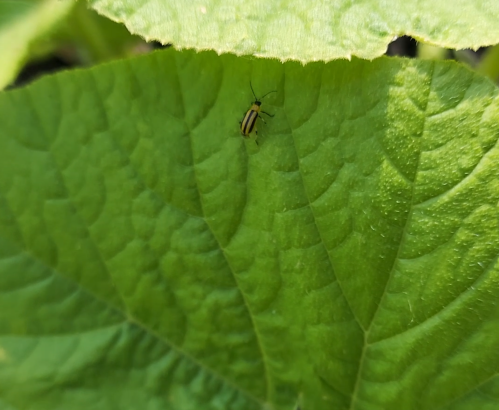
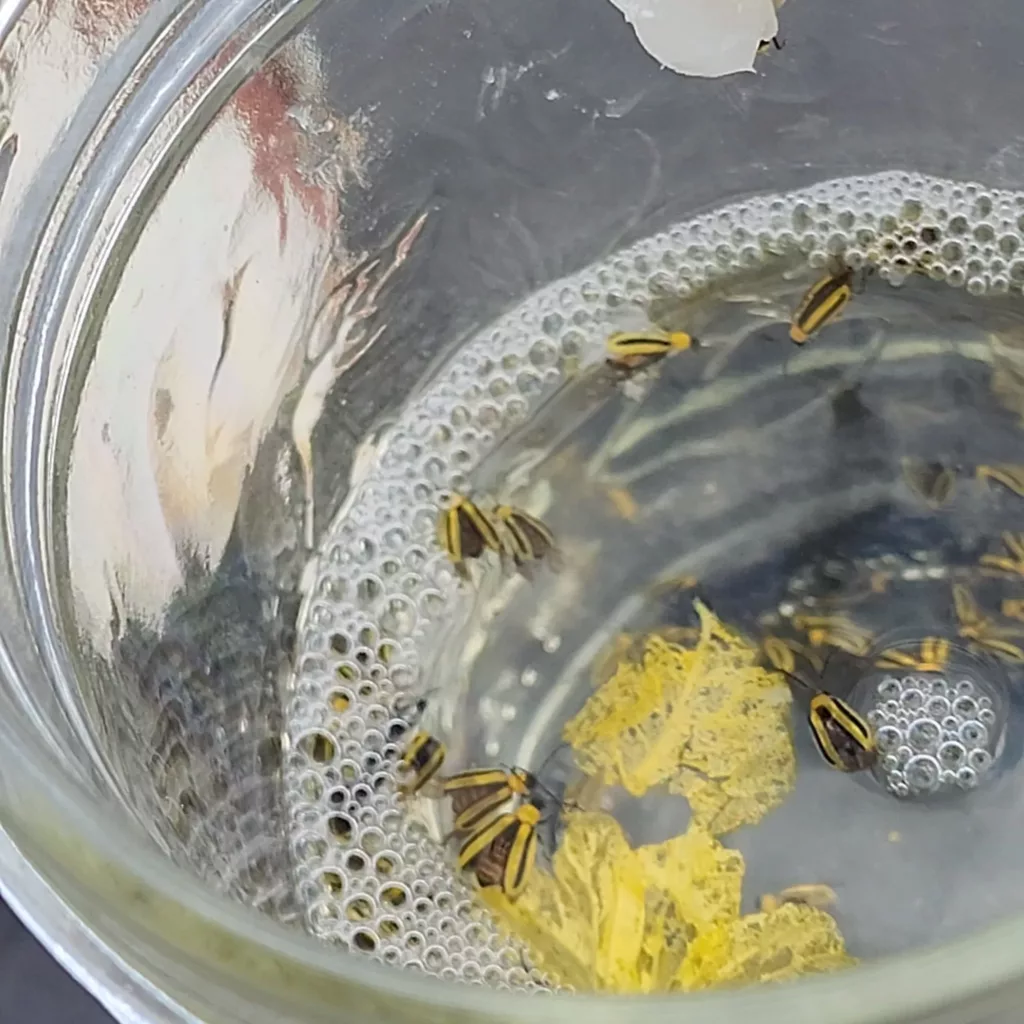
There are two types of cucumber beetles, the striped and spotted one. We have only ever gotten the striped one in our garden in Ontario so that is the one we will discuss. Cucumber beetles attack cucurbits which include cucumbers, summer/winter squash and melons. They are attracted to the yellow flowers of these plants and will eat the leaves and flowers, resulting in your plant producing no fruit (no flower, no fruit). To make matters worse, they can transmit a pathogen called bacterial wilt. One morning your cucumber plant will look happy and healthy and later in the day or the next morning the entire plant is wilted and dead (much like zucchini from vine borers).
The best way to manage these pests is similar to other pests, which is hand picking them into a bowl of soapy water. Check the underside of leaves, and inside of flowers as these are two places they like to hang out. If they are on a leaf, you can put the cup under the leaf and tap it, to drop the beetle into the water.
To help try and prevent adult beetles from laying eggs in your garden, apply a thick layer of mulch around your established plants. If your plant is affected by bacterial wilt, remove the plant so as to not draw in more beetles.
One final note, if you read about cucumber beetles on other websites, you may come across places that say you can use yellow sticky traps to catch them, please don’t. I once accidently left a sticky trap outside that was from one of my houseplants and I caught half a dozen small bees on it, so I do not recommend using this trap.
Squash Vine Borer
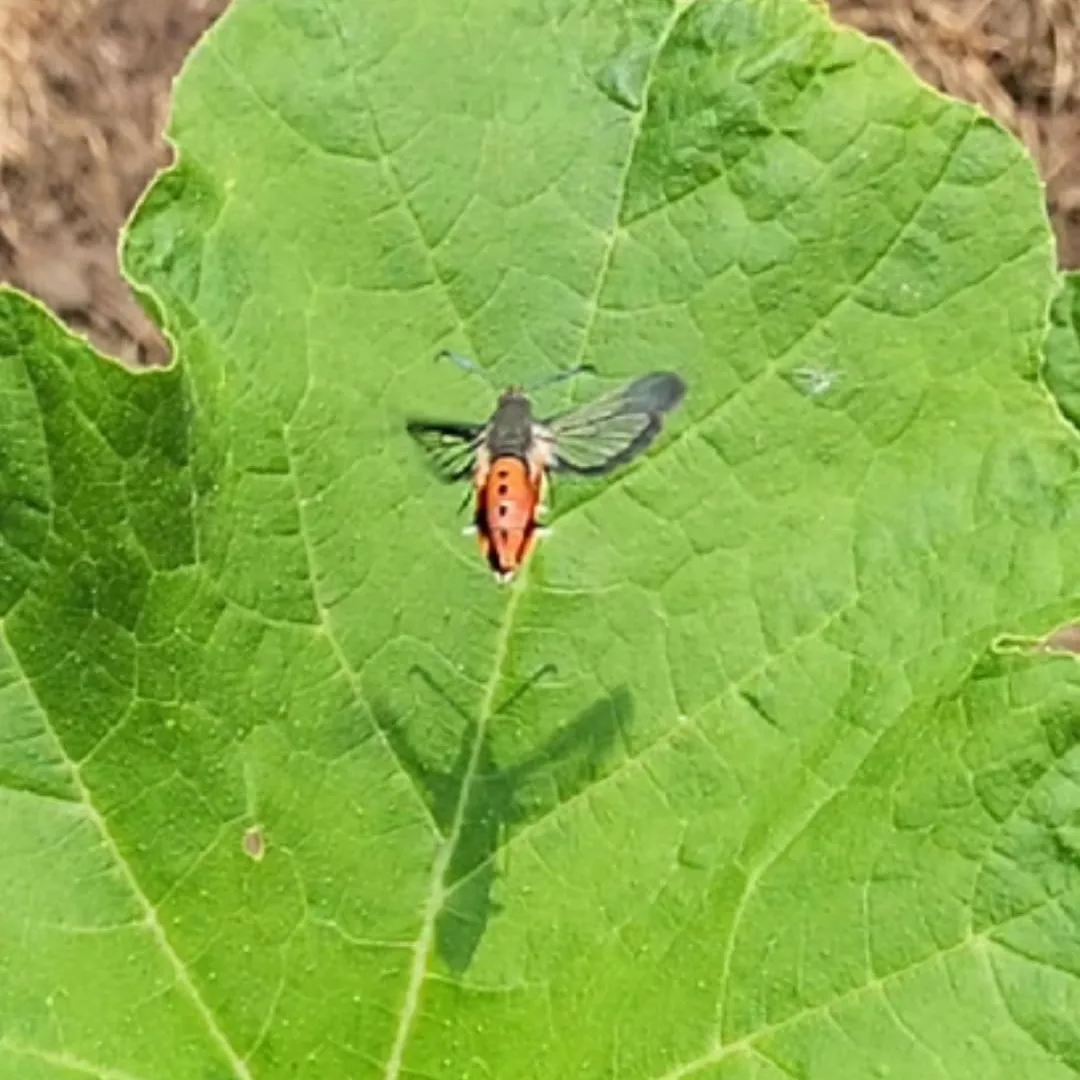
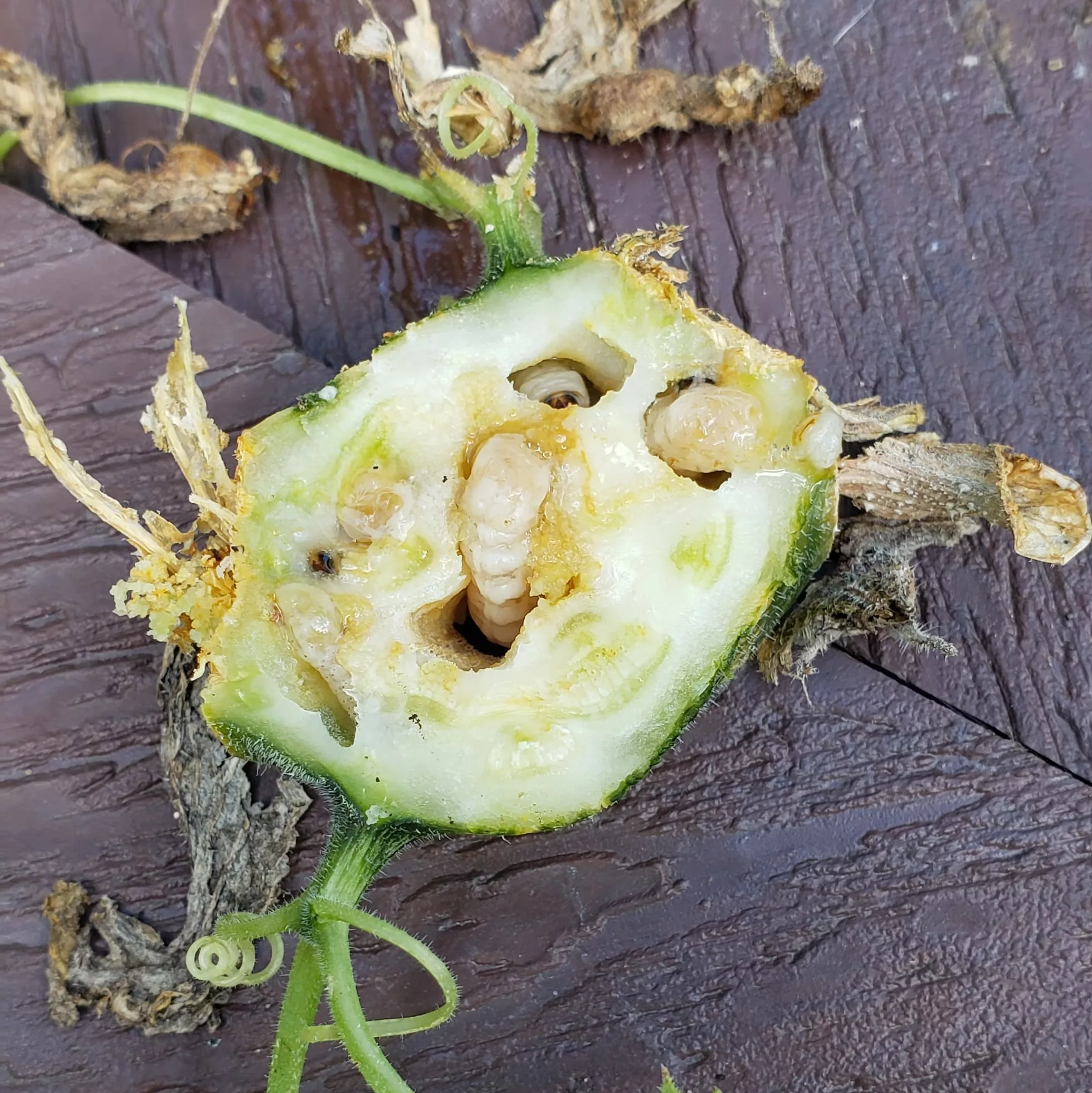
Squash vine borer is on the top of my list for most hated pests, along with the cucumber beetles. It is a pest that you never see coming and only know it’s there when you find a dead plant. These bugs have a particular taste for summer squash (zucchini), winter squash and pumpkins.
Squash vine borer damage is an easily identifiable issue because you go to sleep with a happy living zucchini plant, and you wake up with a wilted dead one. And you ask yourself, “is my zucchini dead? why does my zucchini plant look dead all of a sudden?” And for that, you can thank the vine borer.
As the name suggests, vine borers like to eat the inside of a vine. If you are lucky enough to catch this day-time moth flying around your plant, you might have a chance of slowing down your squash’s demise, if you can catch it. You can also monitor the base of the plant for eggs, however they are small brown eggs that are meant to camouflage with soil. The easiest way to determine soil from egg is the shape of the egg is almost “too perfect” to be soil.
Your final option is to look to the base of the stem, and if you see small holes in it, you know that vine borers are the culprit. But at this point, it’s too late.
The best way to prevent vine borer is to identify any adults in your garden and eradicate them. The next option, is to grow a second planting of summer squash to be planted out in early July. Thus, if you lose your first round of summer squash to vine borer, you already have the next plant ready to go in the garden after the adults have finished laying their eggs.
If you enjoy this article, subscribe to our newsletter for more gardening advice
Colorado Potato Beetle
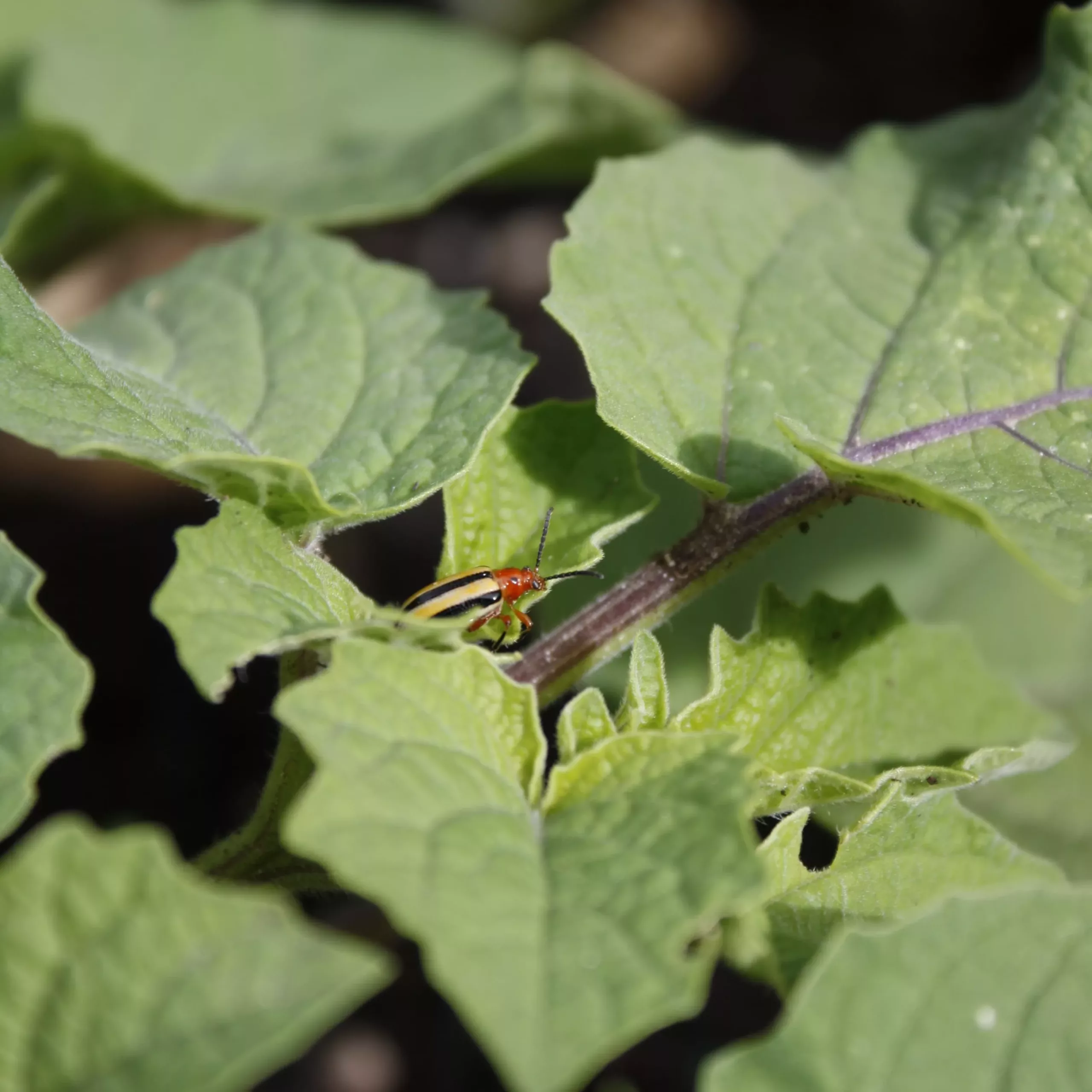
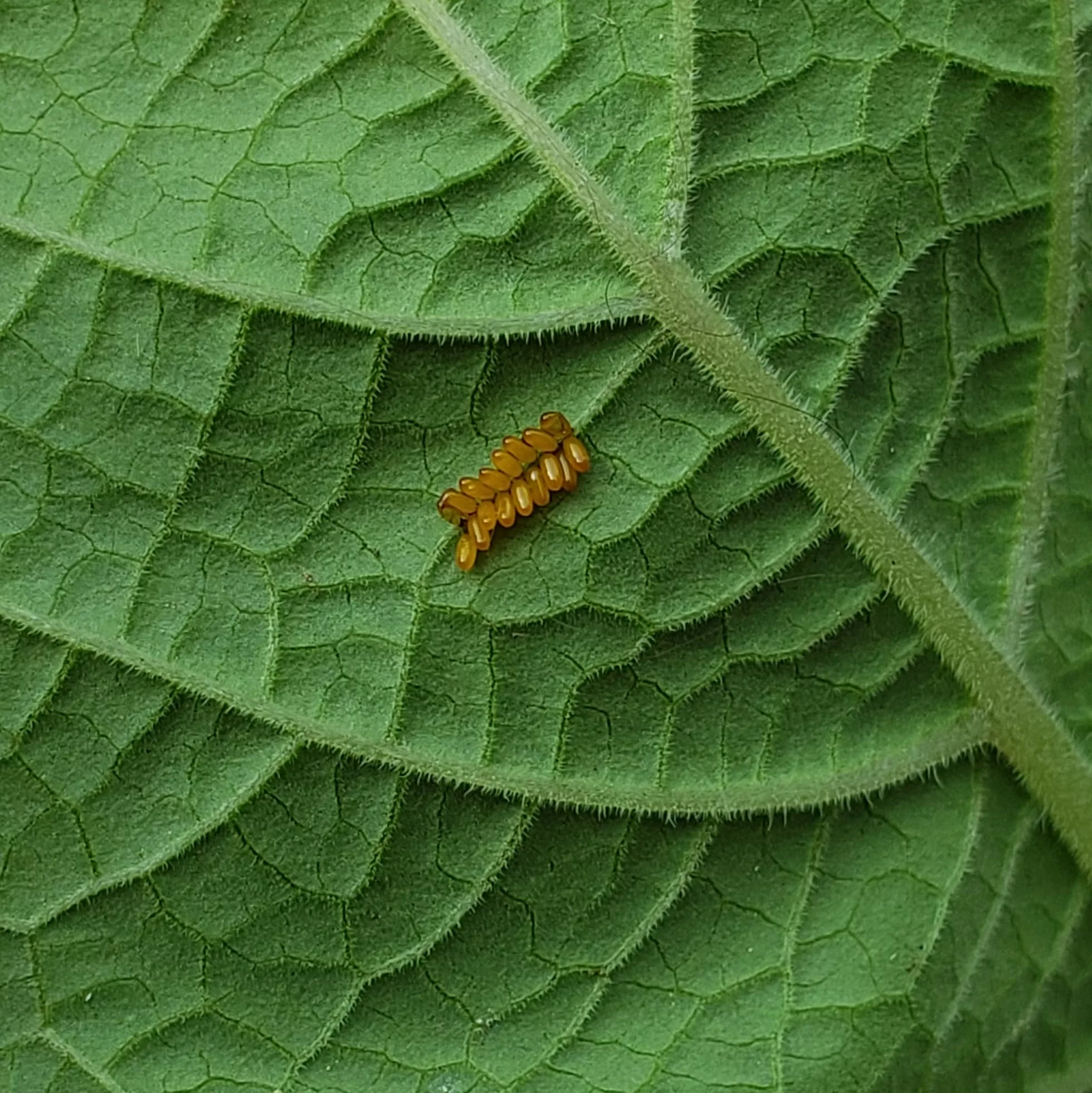
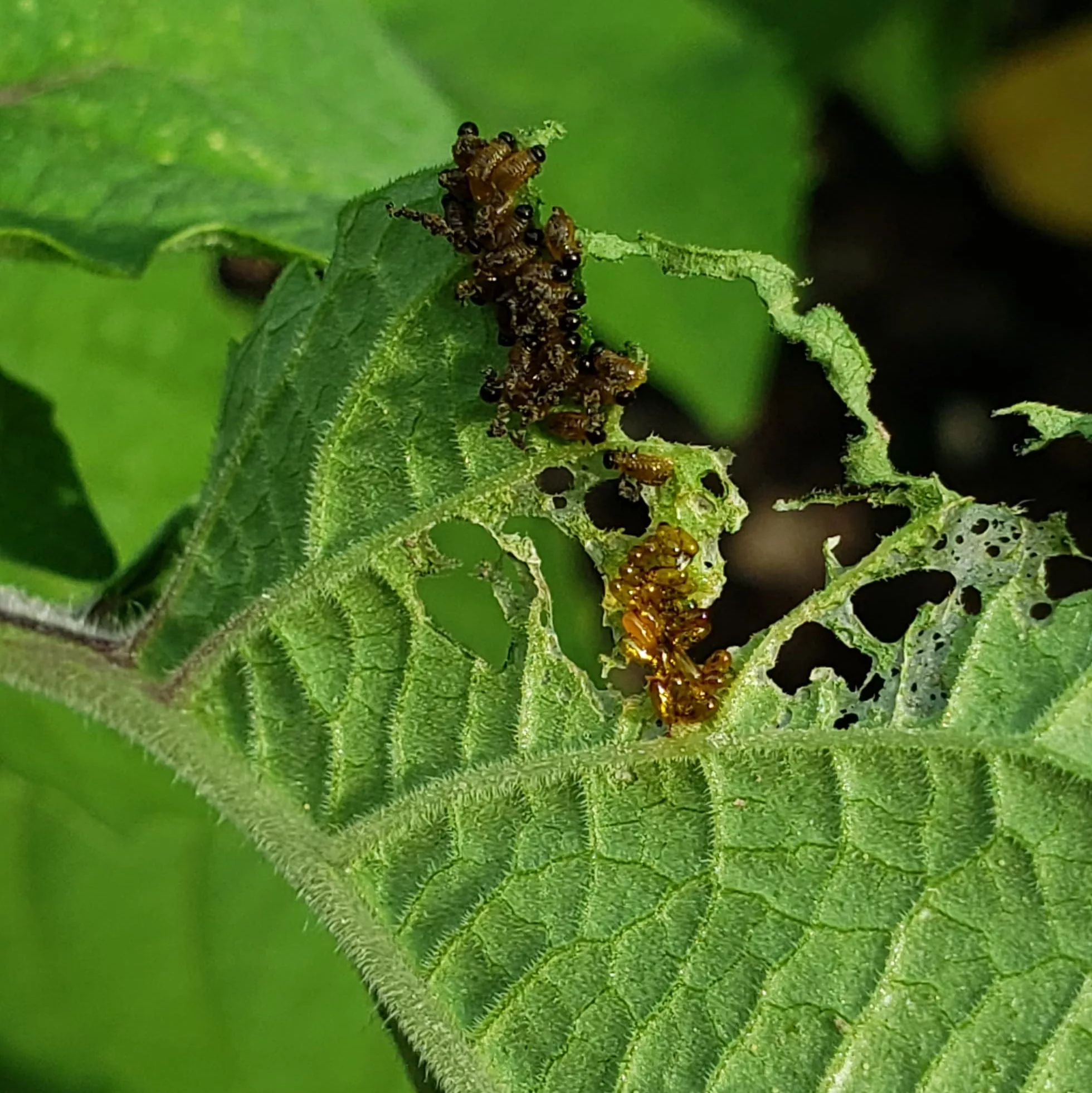
The potato beetle looks very similar to cucumber beetles, with black and yellow stripes on it, however you can tell the difference by their orange heads.
A few years back we had major issues with them eating our ground cherry plants. By the time we caught the issue, there were hundreds of larvae on our plants and they had eaten large portions of the leaves. As the name suggests, they also have a taste for potato plants, as well as other plants in the nightshade family (eggplant, pepper etc).
Your first line of defense is to check the underside of your plants to look for eggs. The eggs are either on the underside of the leaves, but can also be on the flowers. If you find eggs, wipe those off. They are small yellow/orange “pebbles” grouped on the underside of the leaf. Cleaning off eggs can help avoid any form of infestation. A quick note, is that ladybug eggs are also orange and laid in groups. It’s important to note so that you don’t think all orange eggs are “bad” and wipe them off everywhere in your garden.
If you do find adults on your plants, the best way to remove these are by hand picking them off and dropping them into a bowl of soapy water. If you find that the eggs have hatched and the larvae are eating the leaves, pick the affected leaves off and crush them underfoot or under a rock.
The best thing to do once you identify these beetles on your plants is to hand pick them off every single day and monitor for eggs.
Leaf Miner
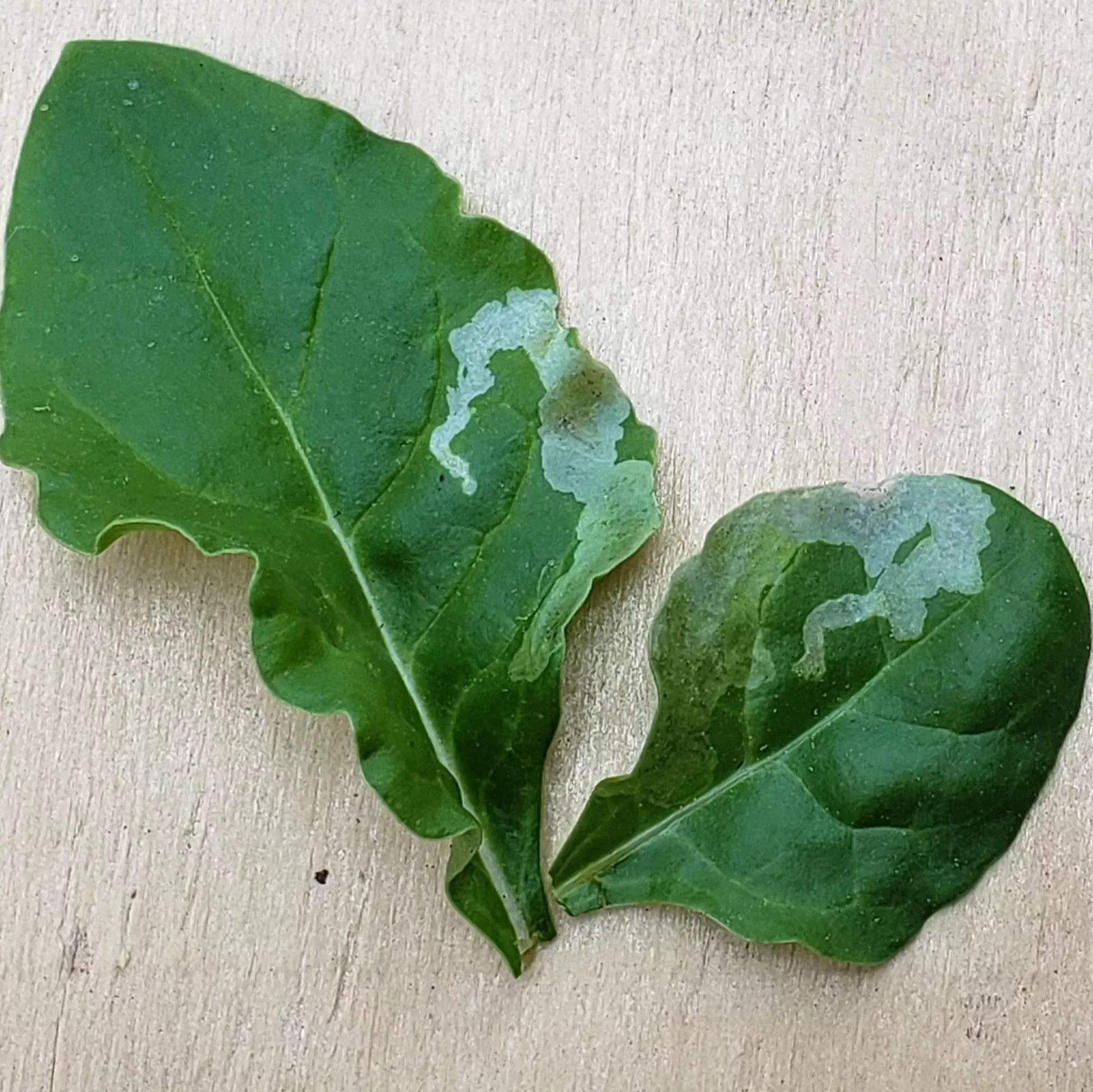
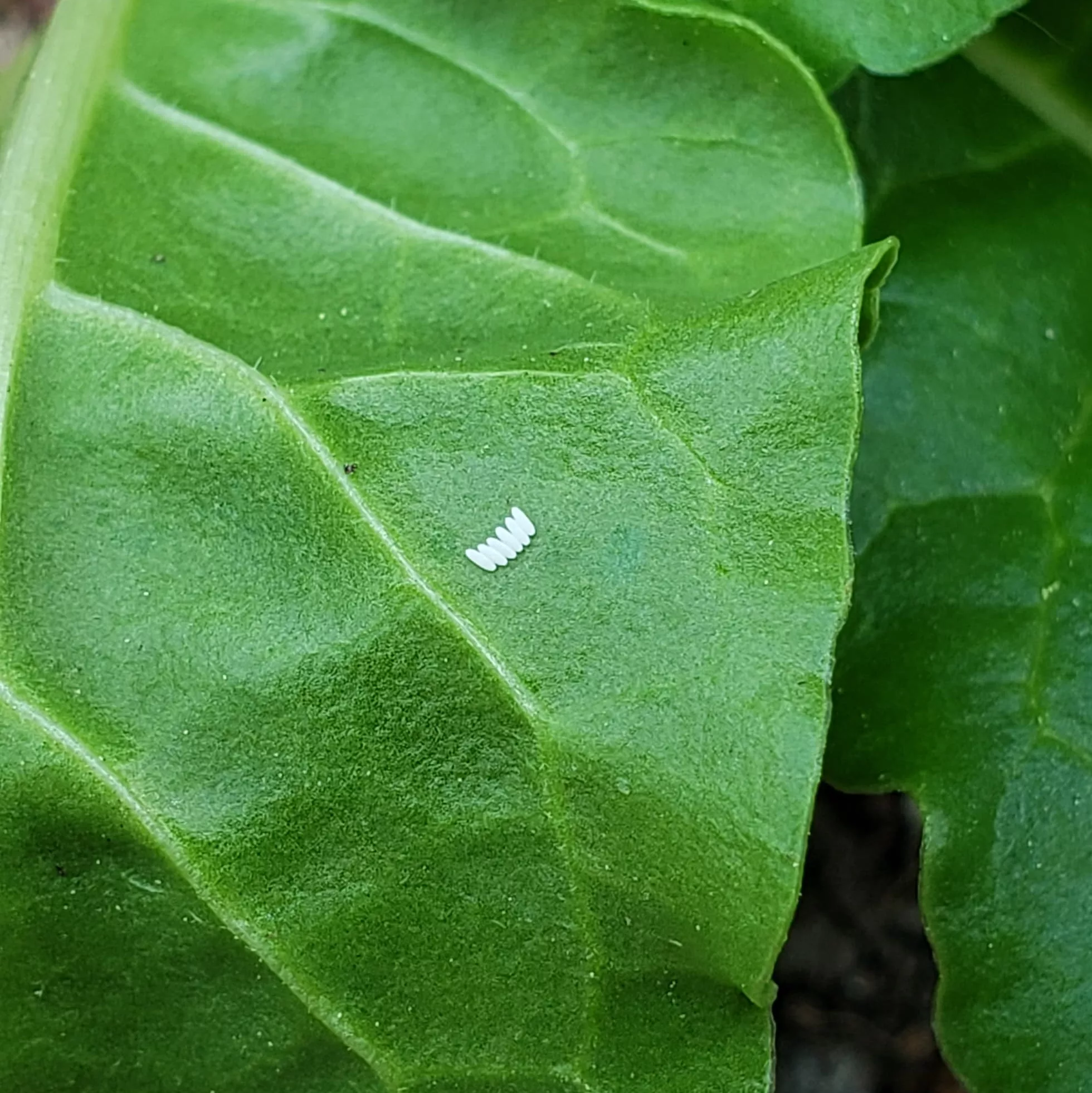
Leaf miners are the larvae of different species of insects that burrow through the leaves of your plants. You can identify them by small maze-like lines through the leaves of your plants, or white/clear spots on leaves. If you are unaware of leaf miners, they can cause major trouble with your leafy greens, particularly in beets and swiss chard, however any leafy plant is fair game for these pests.
Often they are most prevalent in early spring, and are gone by end of June. If managed properly, they will not kill your plant, however they will stunt the growth of your plant if they are not dealt with early on.
The two best ways that we have found to control leaf miners is to remove any leaves that have been severely damaged, and on the remaining plants, look for eggs under the leaves and clean them off. The eggs are generally small, white and in groupings.
For any leaves that have minor damage, pinch the spaces where there is damage and if there is a miner in the leaf, you will likely crush it. The good news is that these leaves are still edible. You will just want to cut the damaged portion off of the leaf.
If you are concerned about losing your veggies to leaf miner, cover your leafy greens with insect netting, or start another set of plants indoors to plant out in mid to late June when their busiest season is over.
Continue growing your garden knowledge:
- How to Grow Nasturtium From Seed to Flower
- How to Grow Bountiful Basil Plants
- 11 Pests in Your Vegetable Garden You Should Know
- How to Grow Lettuce – From Seed to Salad
- What is the best soil to buy for your garden?
Tomato Hornworm

Tomato hornworms are found on, you guessed it, tomatoes! However, they actually will feast on plants from the same family as tomatoes (Solanaceae – the nightshade family), such as peppers, eggplants and potatoes.
The caterpillars will eat every last leaf off your tomato plant if you are not careful and catch these pests early on. To get rid of these hornworms, hand pick them off and move them far away from your garden, but don’t kill them. Also, if you see one covered in white “pebbles”, do not kill it! The caterpillar is still alive and will still manage to do some damage to your plants, however it is dying as a parasitic wasp had laid eggs in it (a beneficial insect in our gardens). The wasp lays its eggs under the skin of the caterpillar, and the larvae will eat their way out. The white “pebbles” you see are actually cocoons. The reason you should leave these caterpillars alive is because you are about to get a whole new generation of parasitic wasps in your garden, which is a really good thing! Not only will they protect you from tomato hornworms, but they also will protect you from aphids and other garden pests.
If you want to learn more about hornworms, or growing tomatoes you can check out our article on how to grow tomatoes from seed to harvest.
Aphids
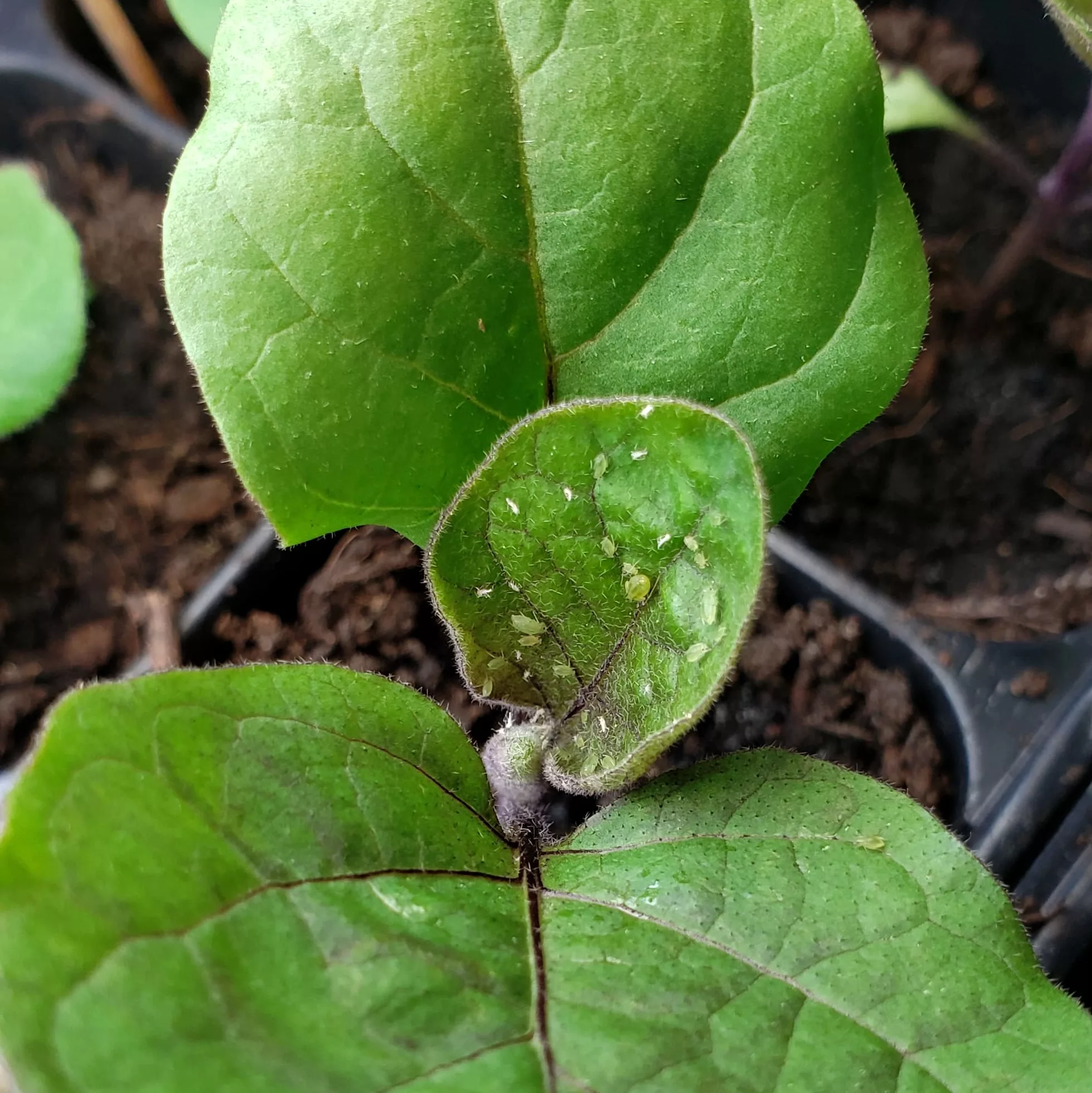
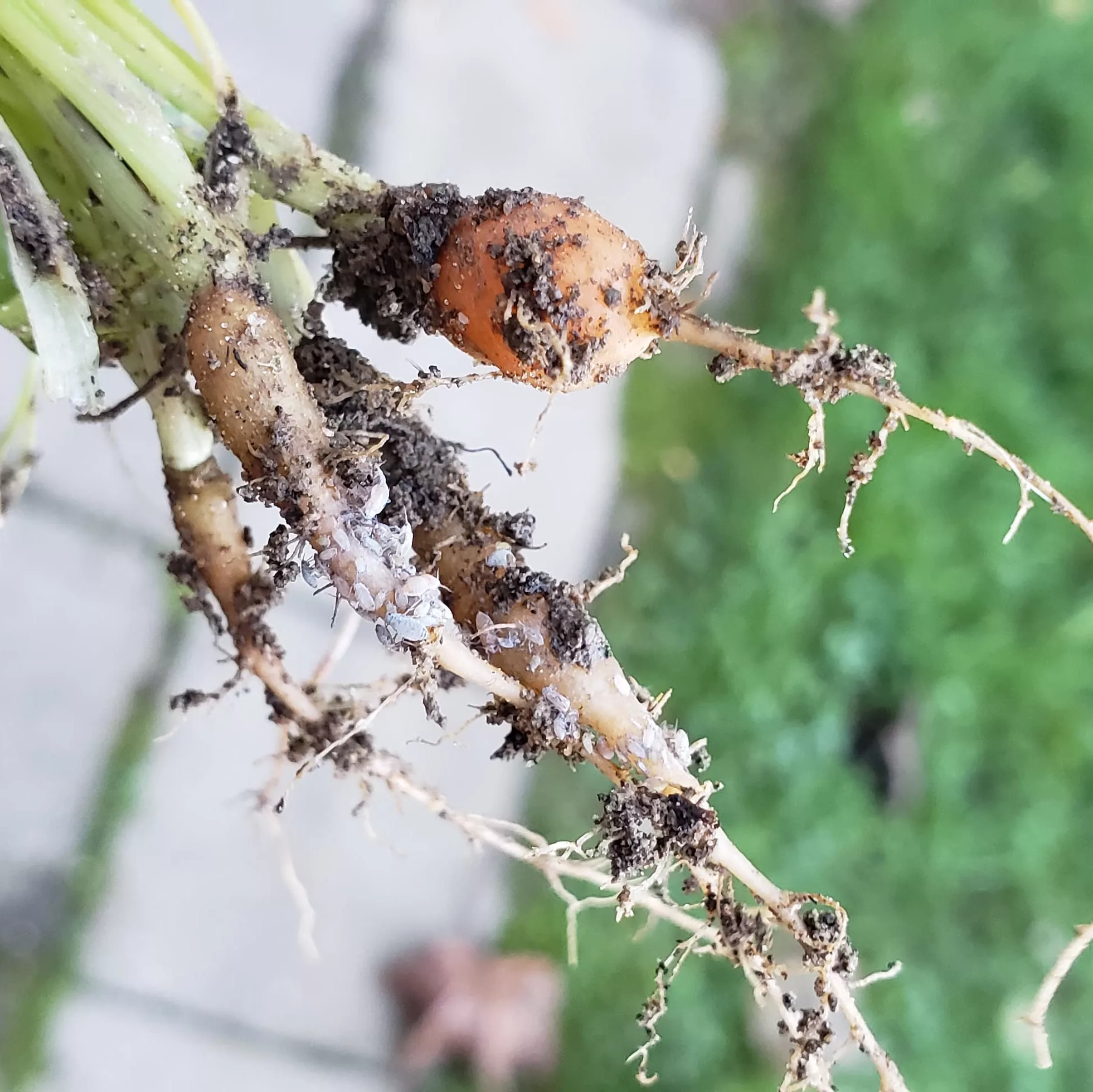
Aphids are small sap-sucking insects that multiply super rapidly. Aphids can be found indoors on your seedlings, outdoors on your plants, or even on root vegetables underground.
With your indoor plants, keep an eye on your seedlings on both the stem, but also the small, newly emerging leaves. They like to hide in the half-rounded leaves that are just unfurling. Because aphids multiple so rapidly, it is important to keep on top of managing them (daily checks are important). It helps to look at the leaves with a light behind them to show the aphids shadow, as they are super well camouflaged. The best ways to manage these pests is to wipe them off with your fingers (and squish them) or to take a piece of clear adhesive tape (scotch tape) and wrap it around your finger – sticky side out – and push your taped finger onto the leaves affected by aphids.
In your outdoor garden aphids can be found in large groups on the stems of plants. The easiest way to manage aphids is to blast a strong stream of water on them to knock them off, but be careful not to damage your plant. Natural predators to aphids include ladybugs and parasitic wasps. Bug hotels are a great way to help attract ladybugs to your garden, and flowers, such as Alyssum attract parasitic wasps.
Join the newsletter to get gardening advice right to your inbox!
Cabbage Moths/Cabbage Worms
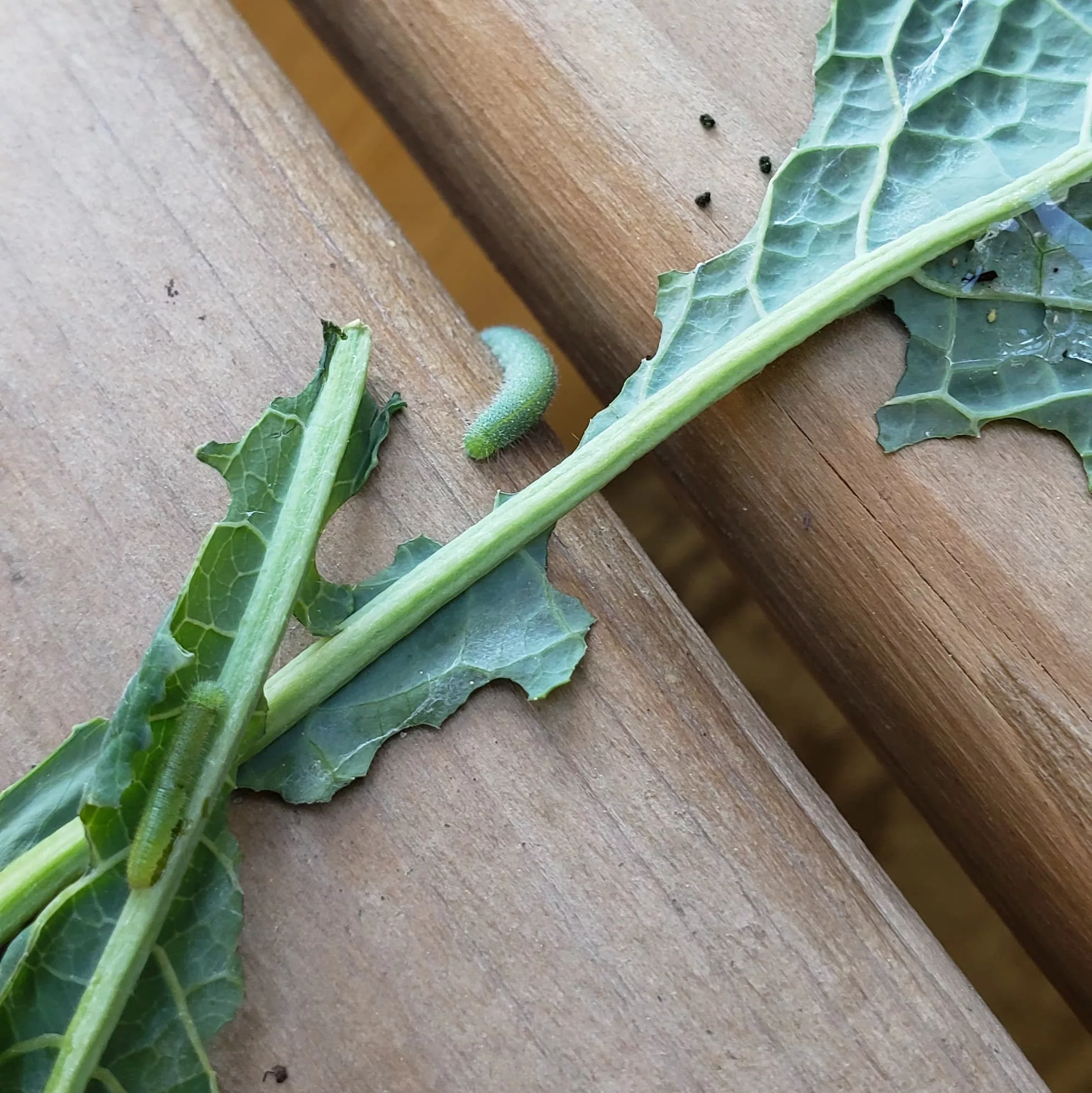
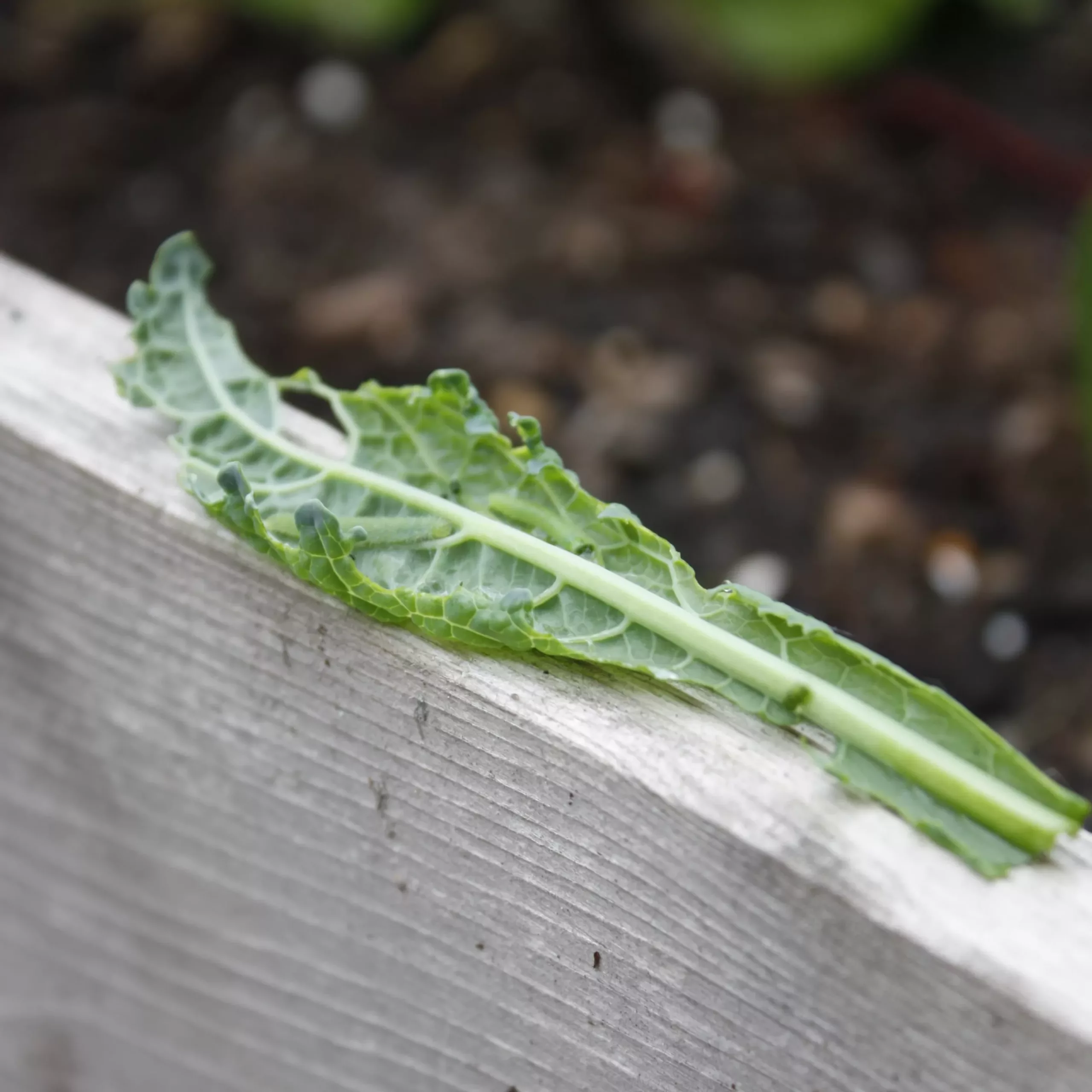
An enemy of brassicas everywhere! The fluttery white butterflies that you see floating around your garden are actually cabbage moths on the hunt for your brassica plants to lay its eggs on. Commonly identified with a single black dot on the outer side of each wing, these are the culprits of the cabbage worm, here to eat every last leaf on your broccoli, cabbage, kale, cauliflower or any other member of the family.
One year I bought myself a butterfly catcher in the hopes of trying to catch these moths before they lay their eggs, but let me tell you, it is very difficult to catch them and you look like a very unhinged person trying to do it. It is much easier to just inspect your plants for eggs and worms.
When you see damage to your brassica leaves it is generally a good indication that you currently have, or at some point, had cabbage worms. They are very well camouflaged so make sure to carefully and slowly inspect your plants.
Some ways to help avoid cabbage worm damage includes; checking the underside of the leaves for eggs and wiping them off, not plant all of your brassica together in one spot, but rather spread them around your garden. Also, plant herbs such as dill and basil around them as the smell of the herbs confuses the moths and mask the smell of the brassicas. Finally, you can use row covers overtop of your plants which will stop the moths from being able to land. Just make sure you do not place this cover over any vegetables that rely on pollinators (such as peppers or tomatoes), and make sure the netting isn’t touching the plants but is hovering over top of them.
Japanese beetles
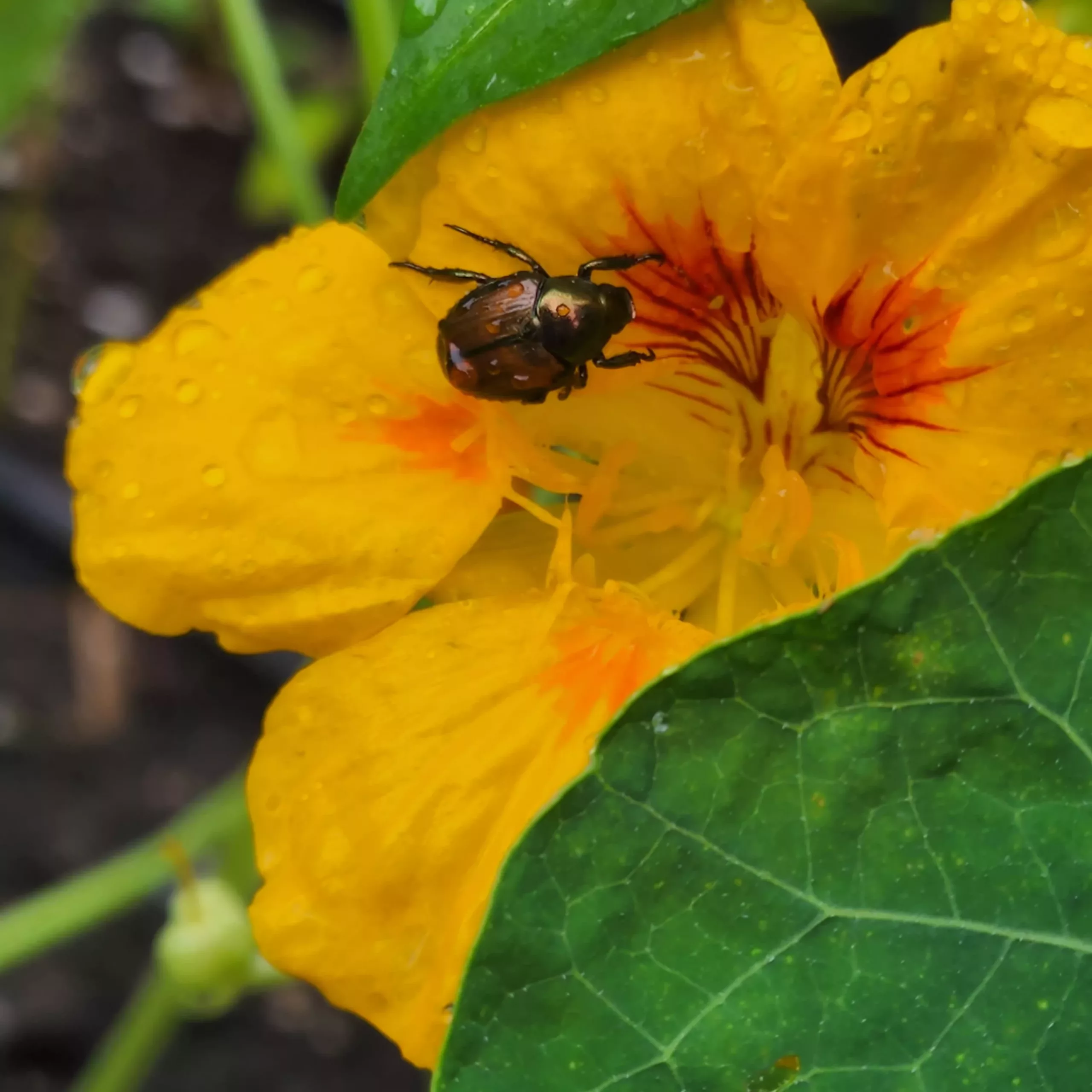
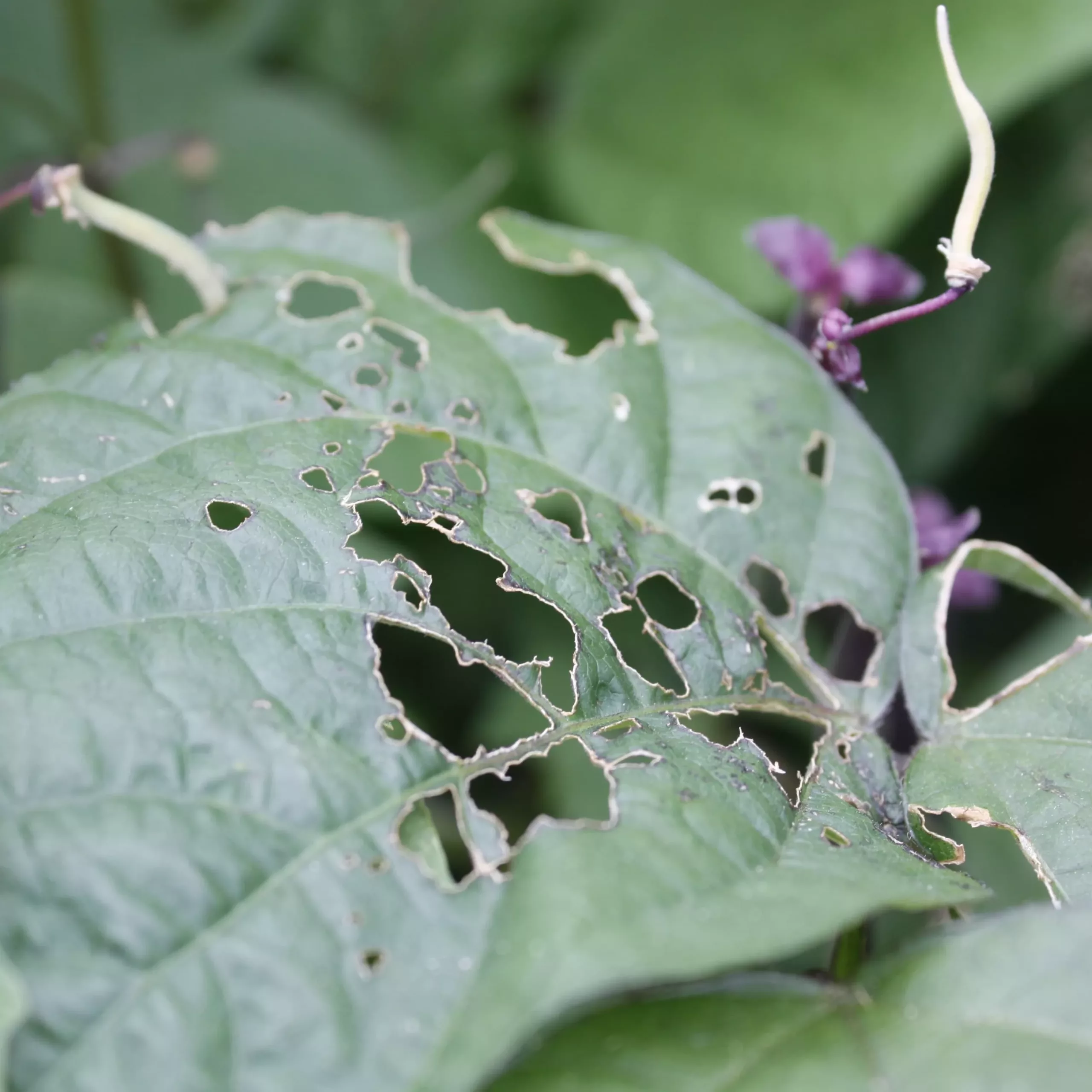
Although they are pretty beetles, with metallic colours on their exoskeleton, Japanese beetles are not a nice find in the garden. They damage plants by eating the leaves (between the veins of the leaf) which is called “skeletonizing”. One of the biggest issues with Japanese beetles is that they have taken over in masses! The sheer number of them is so outrageous that it makes it nearly impossible to stop them.
One good thing is that they are fairly slow and seemingly unaware, making it easy to knock them into a bowl of soapy water. One way to try and reduce the amount of beetles is to buy nematodes sold at most garden centres to spray on your lawn. The grubs are white with dark heads and when you disrupt them they curl into “C” shapes. The larvae can often be found when you dig up in your lawn. If you ever unearth these, make sure to kill them (I like to throw them on a hard surface to feed the robins).
One issue with Japanese Beetles is that they fly, so even if you maintain their populations on your property, if your neighbor has beetles and isn’t dealing with them, they can easily come to your property and continue to damage your plants.
Check out our latest articles:
- How to Grow Nasturtium From Seed to Flower
- How to Grow Bountiful Basil Plants
- 11 Pests in Your Vegetable Garden You Should Know
- How to Grow Lettuce – From Seed to Salad
- What is the best soil to buy for your garden?
Cut worm
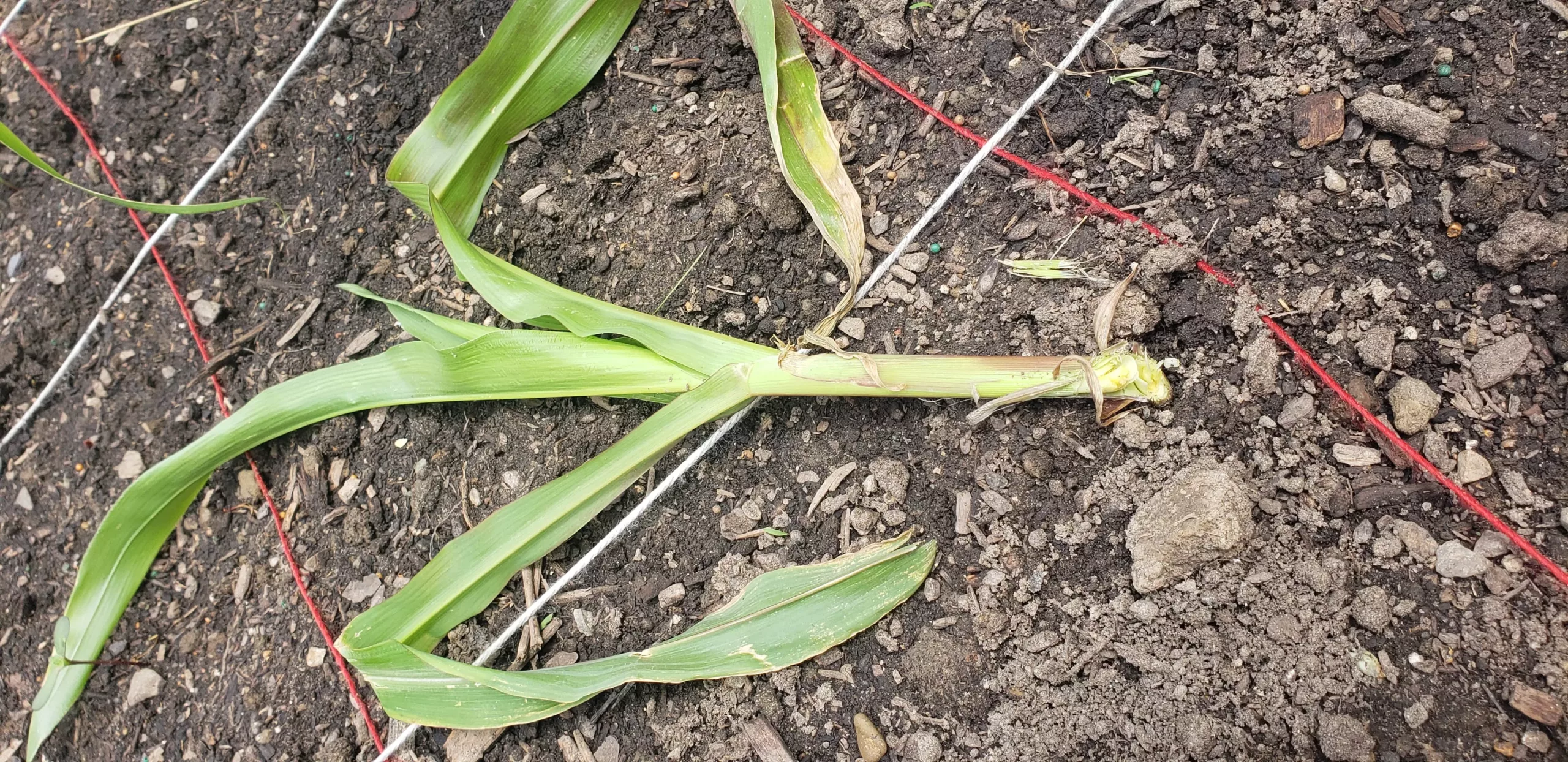
Cutworms are high on my list of irritating pests. When caught early, you can save plants from some pests, however, when you have cutworms, there is no saving them. There may be mornings where you wake up, head out to the garden and find a sunflower or corn lying dead in the soil, perfectly cut at the soil line, and the plant is laying right beside its roots.
I have read online that if one of your plants is taken down by cutworm, to dig down a few inches around the plant and see if you can find it, although, try as I may, I have never been able to locate one.
Cutworms are fairly general feeders so they will eat corn and sunflowers (as I have experienced) but will also eat asparagus, lettuce, peppers, cabbage (to name a few).
The way that cutworms manage to eat the stem so perfectly at the soil line is because they actually curl their bodies around the stem of the plant and eat their way through it (how evil!).
If you are the victim of cutworm, and want to try and avoid future loss, your main option is to go out in the afternoon or evening when they are more active and run your hand or a small rake across the top of the soil to see if you can uncover them. When disturbed they will curl into a “C” shape.
Once a cutworm has found its way to your seedlings it is almost impossible to salvage the damage. The best alternative to deal with them is to start seedlings a few weeks after the first plants and to plant them out later in spring when they are not as actively out damaging plants (late June-ish; however they can be active all summer so it is not a 100% guarantee).
Slugs
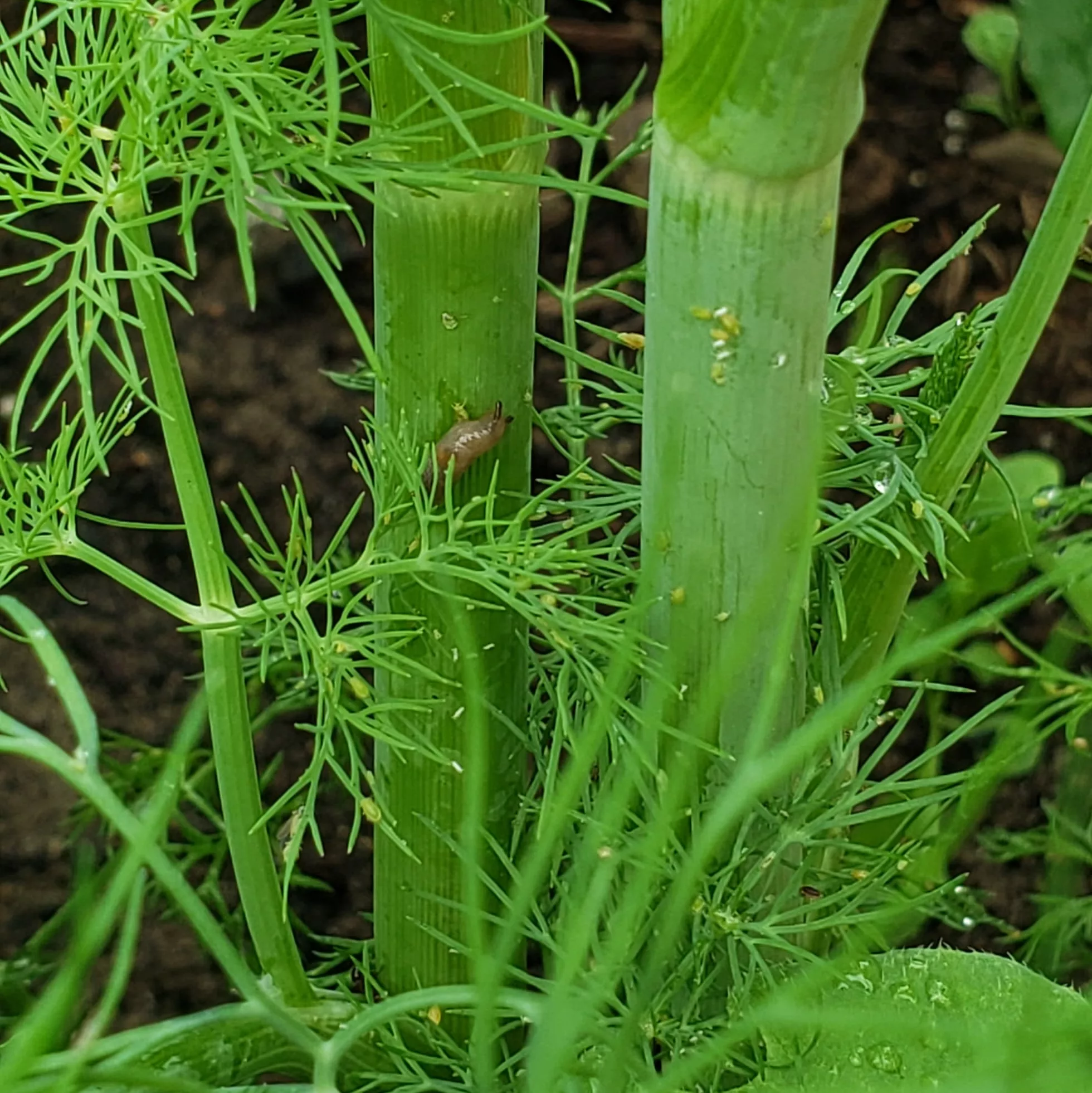
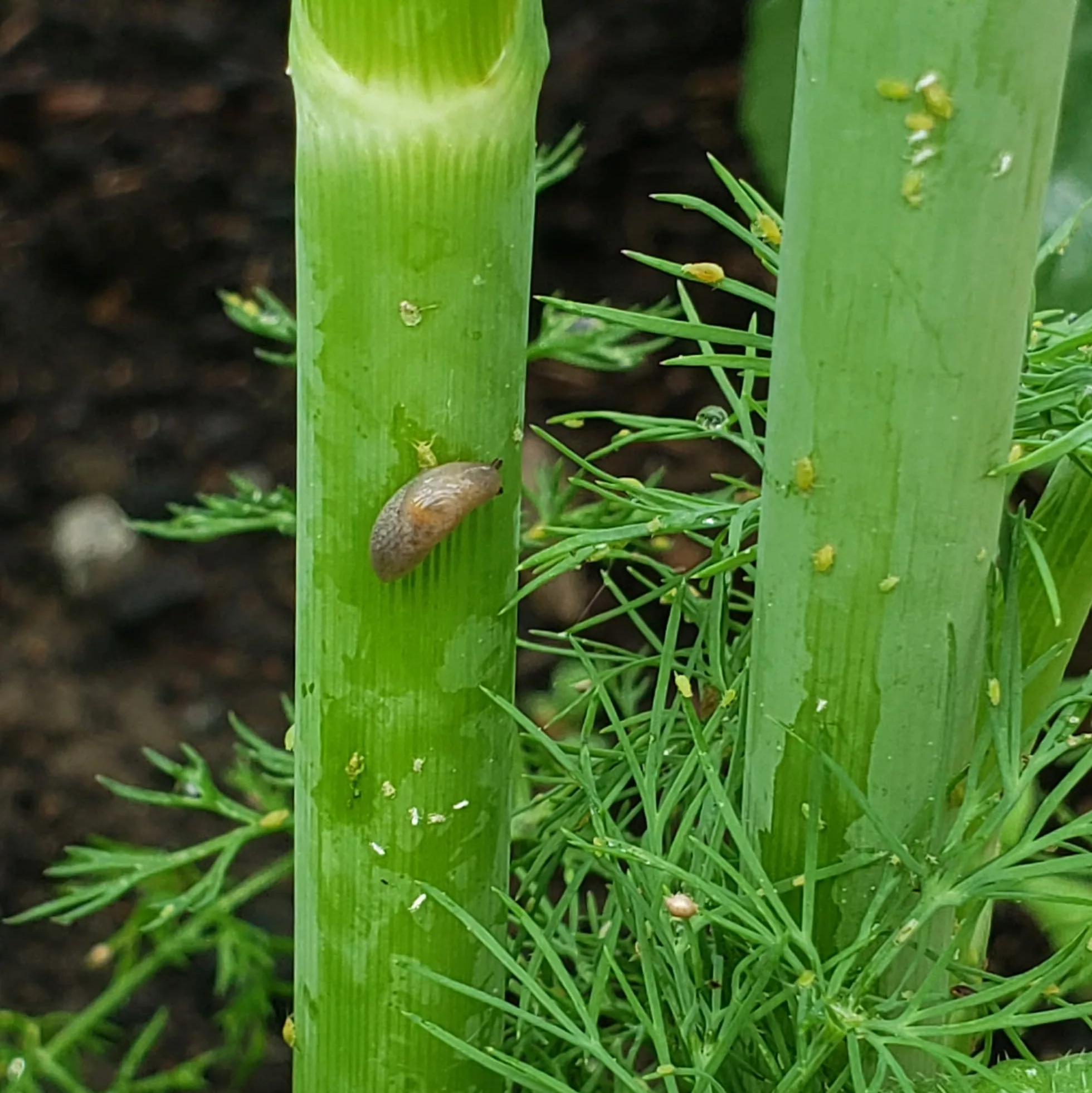
Slugs can be a major issue for some gardeners. When the summers are very wet, it becomes the perfect atmosphere for them. Slugs like dark, damp places, so watering your garden before nightfall can also create the perfect atmosphere.
You know you have slug damage if you see slimy pathways around your garden or on your plants, and if you see bites taken out of vegetable leaves or fruits. They enjoy eating leafy greens such as lettuce and also are big fans of strawberries.
Two ways to reduce slug damage in your garden include, watering in the morning instead of the evening, or going out in the evening and picking slugs out of your garden. If you remove the lower leaves of your plants, taking away places for slugs to hide, it can also help reduce slug issues.
Swede Midge
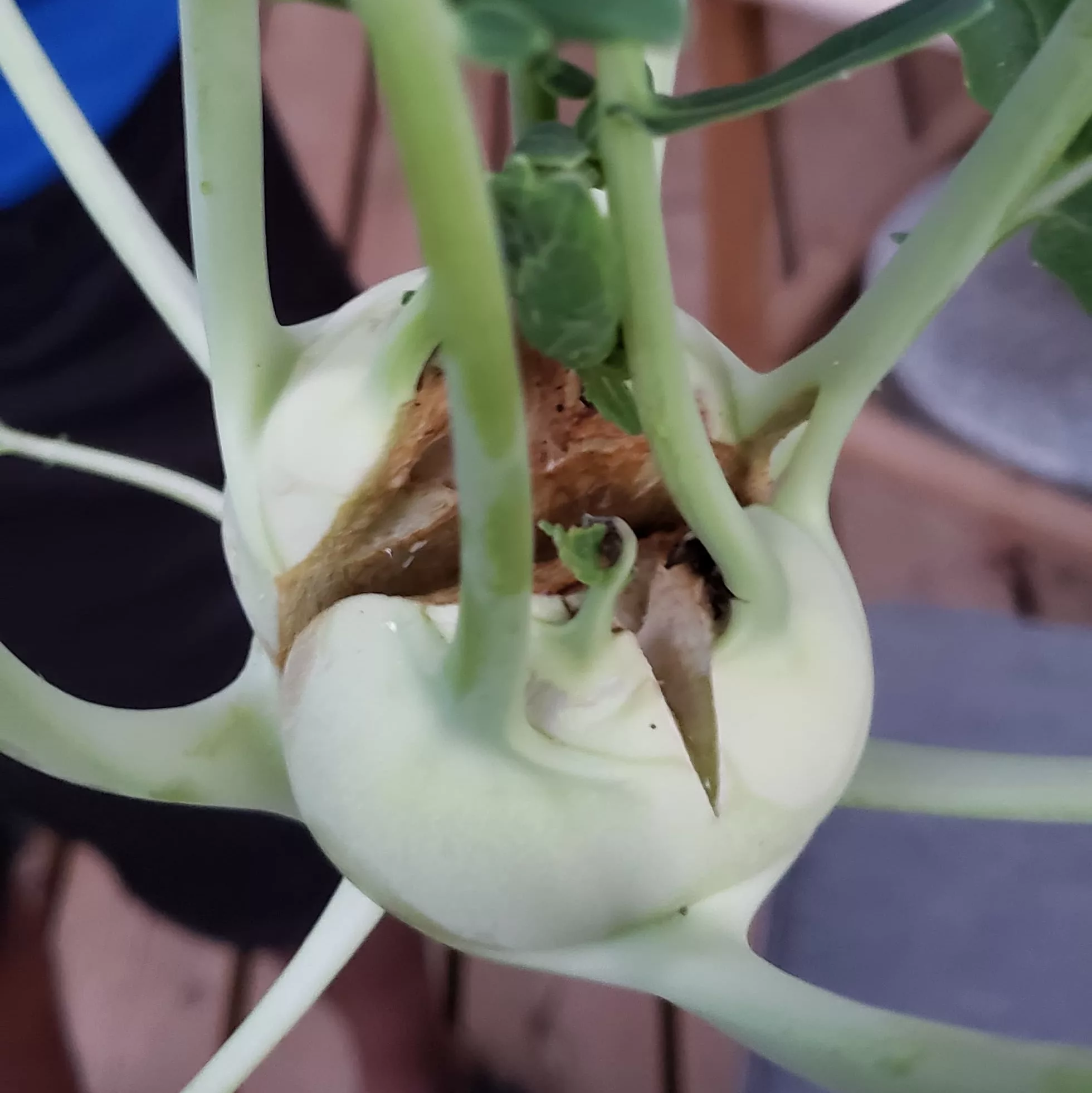
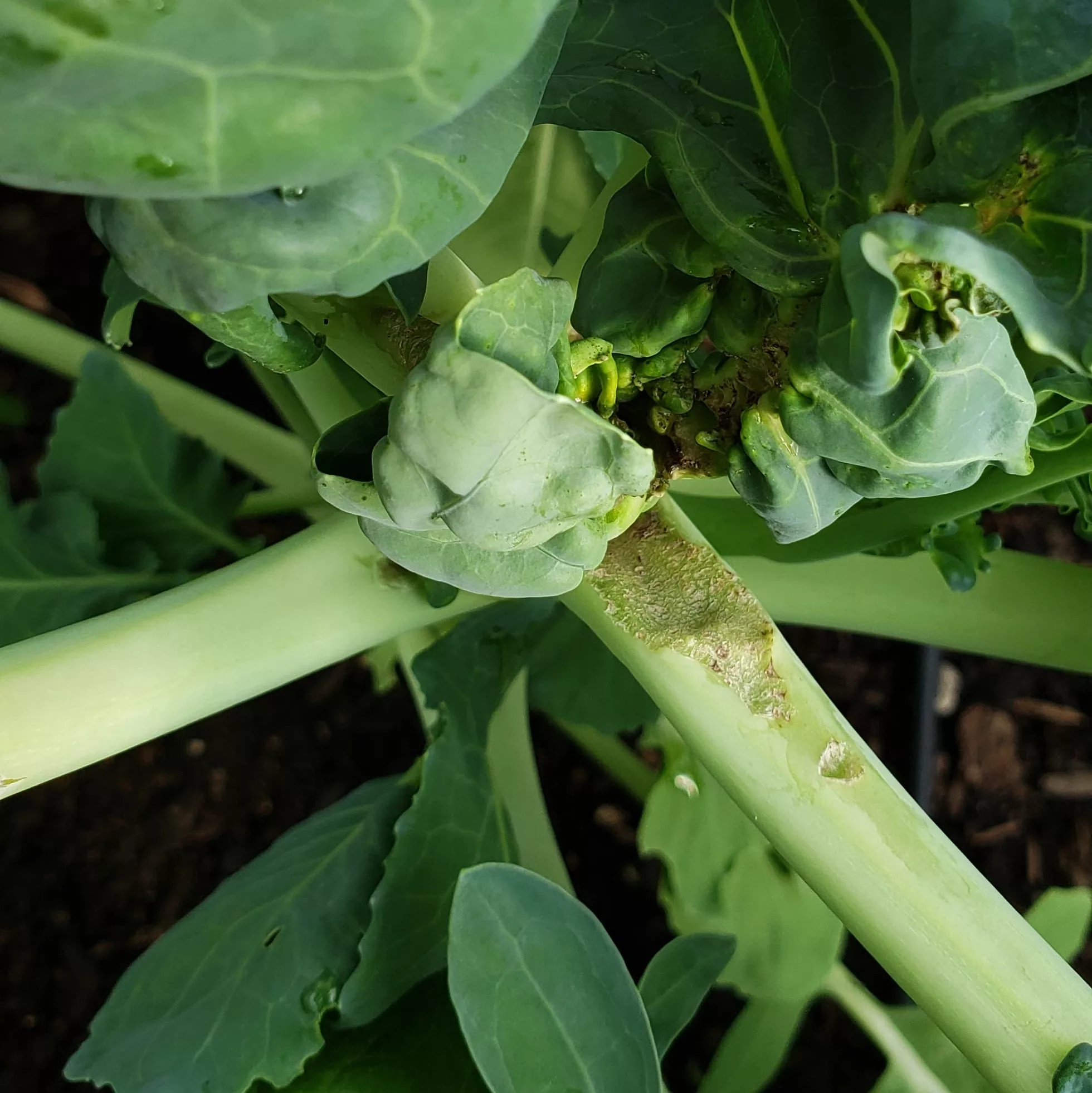
Swede midge is a very new pest on the scene. Finding any information on this pest a few years ago when we had damage from it was nearly impossible to find. It appears at this time that swede midge is only found in the eastern parts of Canada, or potentially only in Ontario.
This pest is a midge, therefore it is extremely small and hard to see. They are poor flyers and tend to travel by wind. The damage on our plants was specifically targeted to the brassicas and caused splitting in kohlrabi, and blindness in broccoli and cauliflower. Blindness refers to damage that causes no head to form on the plant. You will also notice damage on the stem leading toward the centre head – this is indicative of swede midge.
At the time of this writing, there is no solution for swede midge damage. If your plants have been affected by this pest, pull them up as they are no longer viable. Your only option is to avoid planting brassica for a few years or investing in very tight netting to keep the adults out. In a couple of years, you can try and plant it again, under cover to see if your plants will be affected.
I highly recommend reading this article from the University of Massachusetts Amherst to learn more.

